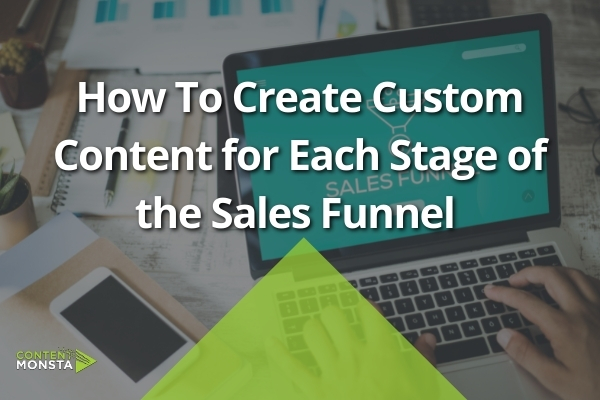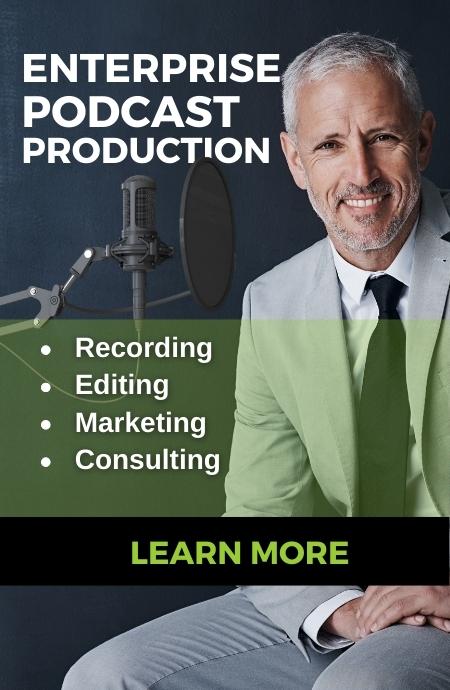In digital marketing, content is the vehicle through which brands communicate with their audience. But for content marketing to hit the mark, it’s vital to tailor your message to suit the audience’s stage in the buying process by creating content for the sales funnel that matches the customer journey.
This is where understanding the sales funnel becomes crucial. The sales funnel is essentially a map of a customer’s journey from first hearing about your brand, to making a purchase.
Creating content that’s specifically designed for each stage of the sales funnel is a strategy that can greatly boost your chances of converting a casual browser into a loyal customer. In the initial stages, the focus should be on creating awareness and piquing interest through educational and engaging content.
As prospective customers move down the funnel, they seek more in-depth information; this is when you present them with detailed content that showcases the value and benefits of your product or service.
At the bottom of the funnel, your content should be geared toward sealing the deal by providing compelling reasons for the customer to take the plunge.
Let’s now unpack this approach in greater depth, exploring the methodologies and nuances of creating finely-tuned content that resonates with audiences at various stages of the sales funnel.
Through content marketing tailored to the sales funnel, you can not only capture the attention but also build relationships and drive action.
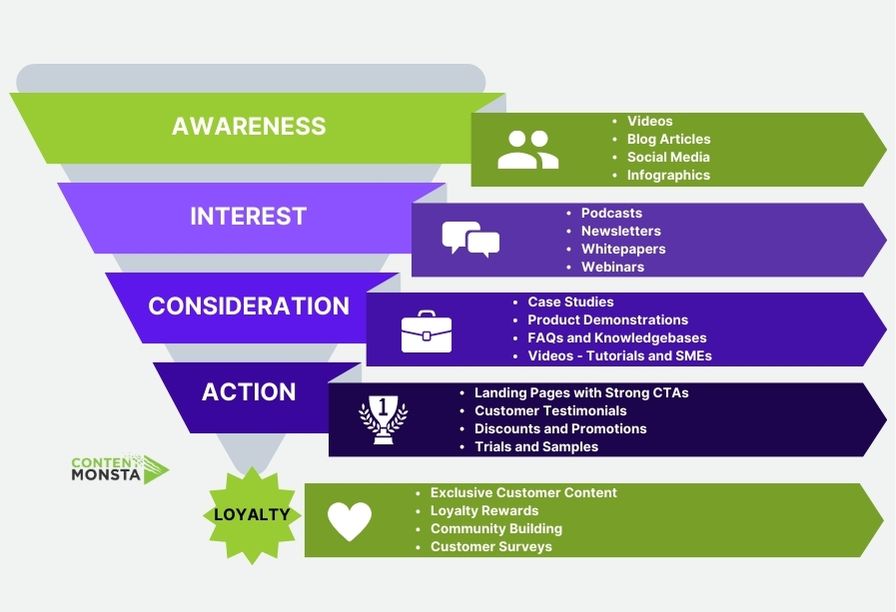
Why It’s Important to Match Your Content to Your Customer Journey
To get a better understanding of creating content for the sales funnel, you must be familiar with the different stages of the sales funnel:
Awareness
The most common entry point for potential buyers. They stumble upon your business through a variety of channels, including blogs, social media posts, and videos. For example, they see an ad about your business/offerings, which leads to an educational blog post.
Interest
Leads now know about your product/service and are actively looking for a solution. They may have followed you on social media or subscribed to your email list. Examples of content in this stage to educate your audience include newsletters, free downloads, eBooks, guides, presentation, case studies, and FAQs.
Consideration
Leads want to make a decision and are trying to figure out if you’re the best solution to their problem. Content to help guide them past this point might include blog posts, guest posts, more in-depth videos/guides/eBooks/whitepapers, webinars, podcasts, and Facebook/Instagram live experiences.
Action
The lead is now ready to buy, but they need a little push. Customer experiences, testimonials, third-party validation, and case studies are effective pieces of content to help alleviate their final doubts and convince them to take the plunge.
Loyalty
Customers are constantly coming back to make another purchase or have a subscription. Content to generate brand loyalty include referral videos, collaborative presentations with strategic partners, quickstart guides, etc.
For the best results, you need different types of content to match the intent of your potential customers. No matter how many quality blog posts you write, they won’t be relevant if you’re not segmenting them based on a customer’s place in the funnel.
For example, a blog post on how your product works isn’t going to really help people still in the awareness stage. So when creating your content, make sure you’re really thinking about who’s going to be consuming it.
How to Create Content for Each Stage of the Sales Funnel
When it comes to content marketing, it’s all about creating the right content for the right customer at the right time. Here’s how to build an effective content marketing funnel with a focus on creating content for the sales funnel.
Top of the Funnel Content
Goal: Spark Interest
The top of the funnel (TOFU) content is the first touchpoint between a potential customer and your brand. At this stage, they’re not ready to buy and are likely just discovering your company. Your goal is to get their attention, offer the best answers to their questions, and subtly introduce them to your brand.

Types of content for Top of the Funnel
Blog Posts
Blog posts are often the first point of contact with potential customers. They are easily discoverable through search engines and shareable on social media. By providing valuable information and insights, blog posts attract a wide audience and establish your brand as an authority in your industry. They address common questions and pain points, which helps in building trust and awareness.
Podcasts
Podcasts serve as a valuable tool in the Top of the Funnel (ToFu) for cultivating brand awareness and establishing authority within a particular niche or industry.
At the ToFu stage, potential customers are often seeking information and insights on topics that interest them. Podcasts allow for in-depth exploration of subjects and provide an intimate way for a brand to connect with its audience.
Through engaging conversations, storytelling, and sharing expert knowledge, podcasts can captivate listeners and subtly introduce them to the brand’s values and offerings without overt sales pitches.
Additionally, podcasts are easily consumable on-the-go, which aligns with the lifestyles of many consumers today. When listeners find value in a podcast, they are likely to subscribe and become regular listeners, creating an ongoing touchpoint for nurturing them through the marketing funnel.
Infographics
Infographics are visually appealing and condense complex information into an easily digestible format. They are highly shareable and an effective way to catch the attention of individuals who may be skimming through content. Infographics can go viral, providing a boost in brand recognition and awareness.
Checklists
Checklists are simple and actionable, providing quick value to the audience. People love checklists because they offer a sense of accomplishment and help them stay organized. Offering a checklist can also be a way to get contact information in exchange, which helps in moving prospects down the funnel.
eBooks
eBooks provide in-depth information on a specific topic and are perceived as high-value content. They are useful for establishing authority and expertise in your industry. By offering eBooks in exchange for contact information, you can also generate leads and build your email list.
How-to Videos
Videos are engaging and can convey a large amount of information in a short time. How-to videos address specific needs or problems and provide a solution. This helps in establishing trust and showcasing the practical application of your products or services without being overly promotional.
Educational Webinars
Webinars allow for real-time interaction with your audience. They offer the opportunity to present in-depth information and insights on topics that are relevant to your target audience. Attendees are often highly interested in the topic, which makes them more likely to engage further with your brand. Collecting registration information is also an effective way to generate qualified leads.

Middle of the Funnel Content
Goal: Guide and Educate
Compared with prospects at the TOFU, prospects at the middle of the tunnel (MOFU) are much more willing to interact and engage with your brand if you encourage them to. They now know about your brand and are looking to learn more about how you can help them.
At this stage, your content should go from introductory to more-in depth. The content you create for the MOFU should be about your brand and how your solution will help your potential customers.
The Middle of the Funnel (MoFu) is where lead nurturing and qualification take place. The content at this stage should focus on providing deeper insights and more specific information that helps leads evaluate their options and consider solutions.
The goal is to establish your brand as the preferred choice by showcasing the value and benefits of your products or services. It’s also important to gather information about the leads at this stage to assess their readiness for a purchase.
Content types that work well in MoFu include webinars, case studies, eBooks, whitepapers, and email newsletters. The focus is on building a relationship with potential customers and moving them closer to a purchasing decision.
Types of content to use for the Middle of the Sales Funnel
Social media posts
Social media is a powerful tool for reaching a large and diverse audience. Through engaging and shareable posts, you can raise awareness about your brand, products, or services, and foster a sense of community among your followers.
Testimonials
Positive feedback from satisfied customers adds credibility to your brand. Testimonials build trust with potential customers by providing social proof that your product or service delivers results and meets customer expectations.
Case studies
Case studies are in-depth analyses that demonstrate how your product or service has helped specific customers. They provide concrete examples and data, which can be particularly convincing for B2B customers or those who are looking for detailed information before making a decision.
Whitepapers
Whitepapers are authoritative guides that provide in-depth information on a specific topic. They are often used to educate the audience on complex issues and to present unique data, insights, or solutions. This can establish your brand as an expert in the field and generate high-quality leads.
Landing pages
Landing pages are designed with a single focus or goal, known as a call to action (CTA). They are an effective tool for converting visitors into leads by providing them with specific information and a clear path to make a purchase or sign up.
Video interviews
Video interviews with industry experts or company representatives can provide valuable insights and humanize your brand. They are engaging and can help in building authority and trust among your audience.
Podcasts
Podcasts work well at both the top and middle of the funnel. Podcasts are a growing medium that allows for in-depth discussions on various topics. By hosting or participating in podcasts, you can reach a dedicated audience, establish thought leadership, and build a personal connection with listeners.
Email newsletters
Regular email newsletters keep your audience engaged and informed about your brand, products, or services. They can be used for various purposes including sharing company news, offering exclusive content, and promoting events or products.
Side-by-side comparisons
These are useful for showing how your product or service stacks up against competitors. By offering transparent comparisons, you can highlight the unique features and benefits of your product, helping potential customers to make informed decisions.

Bottom of the Funnel Content
Goal: Drive Conversions
At the Bottom of the Funnel (BoFu), the content should be aimed at convincing leads to take the final step and make a purchase. This is where you want to address any remaining objections and provide all the necessary information for leads to be confident in their decision.
The goal of BoFu content is to convert qualified leads into customers. This can include offering trials, demos, consultations, detailed product comparisons, and customer testimonials.
Content at this stage should be highly targeted and product-centric, highlighting the unique selling points and showing how your product or service is the best solution for the customer’s needs. At this stage, the focus is on closing the sale and ensuring a smooth transition into the customer journey.
This type of content may include:
Product overviews
A product overview provides essential information about the features and benefits of a product or service. This helps potential customers understand what is being offered and how it can address their needs or solve their problems.
Customer reviews
Customer reviews are authentic feedback from people who have used your product or service. They are a form of social proof that can build trust and credibility, as potential customers often rely on the experiences of others to inform their purchasing decisions.
Success stories
Success stories highlight the positive outcomes that customers have achieved by using your product or service. They showcase real-world examples of how challenges were overcome, and provide potential customers with relatable scenarios that demonstrate the value of what you offer.
Use cases
Use cases provide specific examples of how a product or service can be utilized to solve a problem or achieve a goal. By outlining different scenarios, use cases can help potential customers envision how they might apply your product or service to meet their own needs.
Case studies
Case studies are detailed analyses of how your product or service was used to solve a specific customer problem. They delve into the problem, the solution implemented, and the results achieved, providing evidence and data to support the effectiveness of your product or service.
Tutorials
Tutorials are instructional content that teach users how to perform specific tasks or use certain features of a product. They are especially valuable for complex products or services, as they help users overcome learning curves and utilize the product to its full potential.
Landing pages
Landing pages at the bottom of the funnel are designed for converting leads into customers by providing them a clear path to make a purchase.
Tailoring Content for All Stages of the Funnel and Buying Cycle
At first, it might be difficult to determine what content would work best at which stage of the funnel. But once you really get to understand your customer’s needs, you can get the right content to them at the right time.
The buying cycle is different for each type of business, which means it can’t be replicated from one business to another. So make sure you’re building your content strategy around your customers’ unique buyer’s journey.
For the greatest possible impact on your customer relationships, it’s critical that you get to know your audience, understand their intent at each stage, and create custom content to match each phase of their journey through the funnel.
For more on the tailoring content for each stage of the buyer’s journey, get in touch with us today.
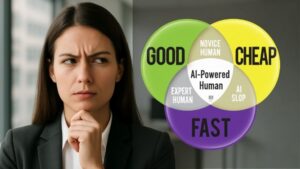
AI + Human Powered Content Marketing: Speed Without the AI Slop
FAST, CHEAP, and GOOD. You can have them all. Speed keeps coming up in client conversations, and for good reason. The meaning of speed has changed. Fast used to mean
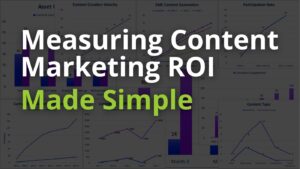
How to Measure Content Marketing ROI
Content marketing ROI is often miscalculated because it is based on a short time frame, a single piece of content, or even a single campaign. Instead, it should be measured

Why Pay for Remote Video Production
If you already have someone on your team who can edit videos, it’s fair to ask, “Why would we pay an outside agency?” In reality, remote video production doesn’t require

